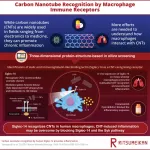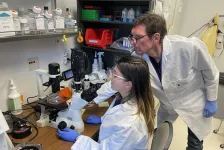(Press-News.org) AURORA, Colo. (April 6, 2023) – Understanding how cancer develops is critical for designing effective, personalized cancer therapies. Researchers have known for years that cancer begins with mutations in certain types of genes. One of these types of cancer genes are so-called “tumor suppressors.” When functioning normally, tumor suppressor genes can stop malignant cells from undergoing uncontrolled cell proliferation and initiate a process of cell elimination called apoptosis, a form of cell death. Mutations in tumor suppressor genes can cause these genes to lose their functionality, eventually contributing to the development of cancer.
In a recent study published in Cell Reports, researchers at the University of Colorado Anschutz Medical Campus described the discovery and characterization of a novel protein involved in a mechanism that suppresses different types of tumors.
The tumor suppressor gene called TP53 effectively restricts the development and growth of many different tumor types across the human body, and it is the most frequently mutated tumor suppressor gene in human cancers. This gene encodes a protein called p53, which is both a potent inhibitor of cell proliferation and an inducer of apoptosis.
According to Zdenek Andrysik, PhD, assistant research professor of pharmacology in the University of Colorado School of Medicine and one of the authors in the paper, “In more than half of cancer cases, TP53 is not mutated, remaining instead in a dormant state. Accordingly, many research efforts have been devoted to the development of drugs that could reactivate this latent form of p53 for cancer therapy. However, most cancers respond to activation of p53 with these medications with a transient block in cell proliferation. A better response to these drugs would be cancer cell elimination via apoptosis. Therefore, it is critical for us to understand what other factors are required for an effective p53-targeted cancer therapy.”
To address this knowledge gap, Maria Szwarc, PhD, and Anna Guarnieri, PhD, former postdoctoral fellows in the department of pharmacology and co-leading authors of the paper, employed a multi-disciplinary experimental approach, including genetic screening using CRISPR technology, to disrupt all genes in the human genome one-by-one and pinpoint which genes are required for full p53 activation. As a result, the screening identified the protein called FAM193A, about which very little was known, as a potent and widespread positive regulator of p53 activity.
“Our follow-up studies revealed that FAM193A is required for the stabilization of the p53 protein and its functionality,” Dr. Szwarc explains. “The results showed that FAM193A interferes with cellular factors that usually repress p53 function, the proteins MDM2 and MDM4, which are commonly overactive in cancers. We found that FAM193A can antagonize the MDM4 protein and thus unleash p53’s ability to stop cancer cell proliferation and survival. In agreement with these findings, we documented that high levels of FAM193A found in certain tumor types is associated with a better prognosis for cancer patients.”
Joaquin Espinosa, PhD, a professor of pharmacology in the University of Colorado School of Medicine, director of the Linda Crnic Institute for Down Syndrome, and head of the research team states, “There was very little, if any, information about FAM193A function when we identified it in our genetic screen as a partner of p53. However, advanced computational analyses of large-scale datasets across hundreds of cancer cell types and human tumors revealed a clear functional connection between p53 and FAM193A. These discoveries bring us one step closer to effective p53-based cancer therapies, which should consider FAM193A. Future research will be aimed at finding ways to bolster the activity of these partner factors for effective tumor suppression.”
About the University of Colorado Anschutz Medical Campus
The University of Colorado Anschutz Medical Campus is a world-class medical destination at the forefront of transformative science, medicine, education and patient care. The campus encompasses the University of Colorado health professional schools, more than 60 centers and institutes and two nationally ranked independent hospitals - UCHealth University of Colorado Hospital and Children's Hospital Colorado - that treat more than two million adult and pediatric patients each year. Innovative, interconnected and highly collaborative, the University of Colorado Anschutz Medical Campus delivers life-changing treatments, patient care and professional training and conducts world-renowned research fueled by over $690 million in research grants. For more information, visit www.cuanschutz.edu.
###
END
ITHACA, N.Y. – To manage atmospheric carbon dioxide and convert the gas into a useful product, Cornell University scientists have dusted off an archaic – now 120 years old – electrochemical equation.
The calculation – named the Cottrell equation for chemist Frederick Gardner Cottrell, who developed it in 1903 – can help today’s researchers understand the several reactions that carbon dioxide can take when electrochemistry is applied and pulsed on a lab bench.
The electrochemical reduction of carbon dioxide presents an opportunity to transform the gas from an environmental liability to a feedstock ...
Currently, 12.5% of U.S. adults smoke cigarettes. At the same time, more than one-third of U.S. adults seek health information online, making social media a potentially powerful platform for anti-tobacco campaigns. However, limited research has been done on effective social media strategies for anti-smoking campaigns.
An interprofessional Mason research team led by Associate Professors in the Department of Health Administration and Policy Hong Xue and Gilbert Gimm found that the most popular anti-tobacco campaigns on Facebook were informational and discussed the negative effects of smoking. ...
East Hanover, NJ – April 6, 2023 – Ada Chen, PhD, at Kessler Foundation was awarded a two-year grant for $187,000 from the Craig H. Neilsen Foundation to improve the return-to-work rate and employment outcomes for inpatients with spinal cord injury (SCI). Her study is titled “Employment after SCI: Stakeholder Perceptions and Experiences of Vocational Resource Facilitation.”
“The Vocational Resource Facilitation (VRF) pilot project – developed as an early intervention – has already shown promising outcomes in improving return-to-work rates,” said Dr. Chen. “Further investigation of VRF participant and stakeholder experiences and perceptions ...
FOR IMMEDIATE RELEASE
A new drug, a monoclonal antibody known as enoblituzumab, is safe in men with aggressive prostate cancer and may induce clinical activity against cancer throughout the body, according to a phase 2 study led by investigators at the Johns Hopkins Kimmel Cancer Center and its Bloomberg~Kimmel Institute for Cancer Immunotherapy. If confirmed in additional studies, enoblituzumab could become the first promising antibody-based immunotherapy agent against prostate cancer.
In a clinical trial, 32 men with high-risk or very high-risk prostate cancers who were scheduled ...
Carbon nanotubes (CNTs) have become a mainstay of the field of nanotechnology. Finding innovative applications across materials science, electronics, and medicine, CNTs have garnered a lot of attention from researchers in recent years. However, the International Chemical Secretariat (ChemSec) has moved to flag CNTs on the “Substitute It Now!” database of chemicals likely to be restricted for use. In fact, due to their persistence in nature and potential toxicity to humans, ChemSec has proposed that adequate assessments of CNTs' risk to human health are urgently needed.
Following their entry into the body, and much like asbestos, CNTs are targeted by the immune system and preferentially ...
A key enzyme in sugar metabolism is inactivated particularly easily and efficiently by oxidative stress. Scientists at the German Cancer Research Center (Deutsches Krebsforschungszentrum, DKFZ) have now shown that with this oxidation, cells switch to an alternative sugar breakdown pathway and can thus escape oxidative stress. Cancer cells in particular benefit from this mechanism, which can also protect them from therapy-related damage.
One of the central enzymes in sugar breakdown, GAPDH (glyceraldehyde-3-phosphate dehydrogenase), ...
Think about how frustrating it is to try to fit a gift into a box that is too small. Sometimes you just need a bigger box.
Building a bigger box
Nanocages are tiny artificial containers that can be used to deliver therapeutics to a target destination in the body. But some drug molecules are like gifts that are too big for a standard-sized nanocage ‘box’. Now, in an article published today in Nature Synthesis, researchers from the University of Cambridge describe how they have built a super-sized nanocage that could be used to deliver larger drug cargoes. They have built a bigger box.
Simple building blocks
Rational control over the self-assembly of these types of cages generally ...
Understanding why certain materials work better than others when it comes to energy storage is a crucial step for developing the batteries that will power electronic devices, electric vehicles and renewable energy grids. Researchers at Drexel University have developed a new technique that can quickly identify the exact electrochemical mechanisms taking place in batteries and supercapacitors of various compositions — a breakthrough that could speed the design of higher performing energy storage devices.
Reported in Nature Energy, the Drexel team’s ...
Researchers at the University of Washington School of Medicine in Seattle have engineered stem cells that do not generate dangerous arrhythmias, a complication that has to date thwarted efforts to develop stem-cell therapies for injured hearts.
“We have found what we have to tackle to make these cells safe,” said Silvia Marchiano, a postdoctoral fellow in the laboratory of Chuck Murry at the UW Medicine Institute for Stem Cell and Regenerative Medicine. Marchiano is the lead author of a paper describing the findings published Thursday, April ...
Of the many different kinds of stars, asymptotic giant branch (AGB) stars, usually slightly larger and older than our own sun, are known producers of interstellar dust. Dusty AGBs are particularly prominent producers of dust, and the light they shine happens to vary widely. For the first time, a long-period survey has found the variable intensity of dusty AGBs coincides with variations in the amount of dust these stars produce. As this dust can lead to the creation of planets, its study can shed light on our own origins.
You’ve probably heard of the James Webb Space Telescope (JWST) which ...



